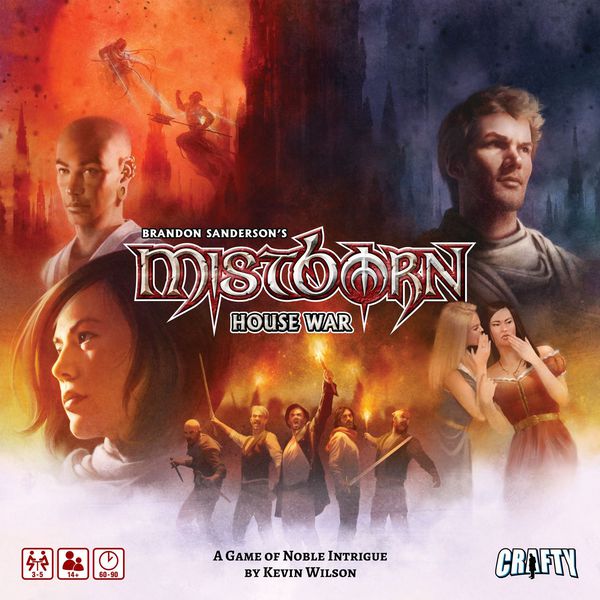Healthy Heart Hospital Board Game Review
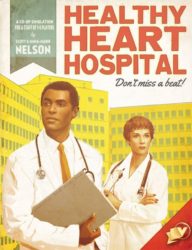
Healthy Heart Hospital is a cooperative game for 1 to 5 players from designers Scott and Anna-Marie Nelson and publisher Victory Point Games.
In Healthy Heart Hospital players assume the roles of doctors and hospital administrators attempting to bring prestige back to Healthy Heart after the previous administration left it a mess.
Prestige is earned by curing patients and expanding your hospital. If players are able to make it through the ambulance card deck, they win the game. If players go broke or run out of places to put dead patients, they lose.
Do you have what it takes to bring Health Heart back?
How to play Healthy Heart Hospital
To set up the game, players lay out the board and add the Prestige and Money tokens on their respective tracks (money is set to 5). The Ambulance cards are shuffled and placed in a face down draw pile below the board. Hiring markers are randomly placed face down along the Job Line. Training tokens are shuffled, placed in face down piles with two tokens being revealed face up near the stacks.

Five bed tokens are then randomly drawn and placed in the Wards corresponding to their color and placed on their “two” or “three” sides. The remainder are set near the board for later use.
Next players shuffle the Ward Ability tiles and draw 4 at random, assigning one to each Ward.
Players will then draw 4 Doctor cards and one Administrator card and divide these up among the players equally. Players will additionally take two action tokens per doctor and the corresponding tokens for the Administrator.
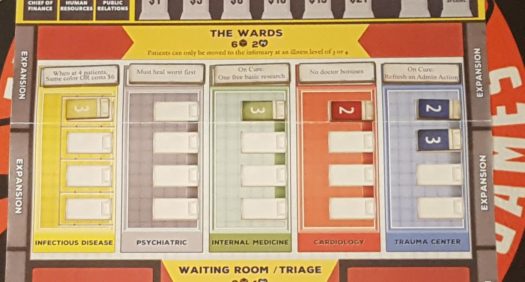
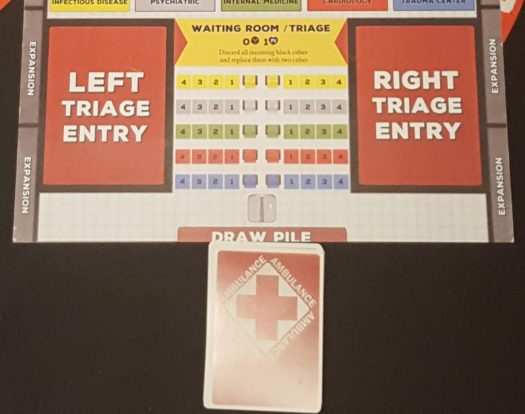
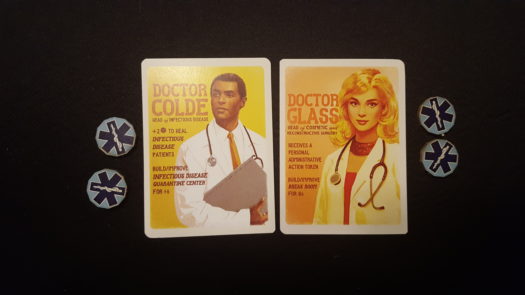
Expansion cards are set near the board for later use. All Sickness cubes are placed into a draw bag or cup and all other tokens are placed in a pile near the board.
Players are now ready to begin play starting with the Ambulance phase.

Ambulance Phase
Each round begins with players revealing one Ambulance card in the left triage space and one Ambulance card in the right triage space. The number on these cards indicate the number of Sickness cubes players will draw from the cube cup and place on the card. Players draw one cube at a time until the number is reached. If a black cube is drawn, players discard it and draw two additional cubes in its place.
Once all cubes have been drawn, players will move the cubes from the card to the waiting area filling each seat with one cube of the matching color. Note: each waiting area (left and right) only has four seats per sickness type. If there are more cubes than seats, that patient is DOA. The cubes are discarded and players must deal with the dead body (more on this later).

Player’s will now do “rounds” by drawing one cube per bed in the Wards (one at a time). If a cube is drawn that matches the bed color, that patient gets sicker and the bed is flipped to the next higher number (or replaced by a new bed with a higher number).
If a non-matching cube is drawn, nothing happens. If a black cube is drawn, players must draw two new cubes for that patient and compare the results. And if the patient goes from a 4 to a 5, that patient dies (see “death” below).
Once players have drawn cubes for all the patients, the cubes are discarded and players move on to the Player’s phase.
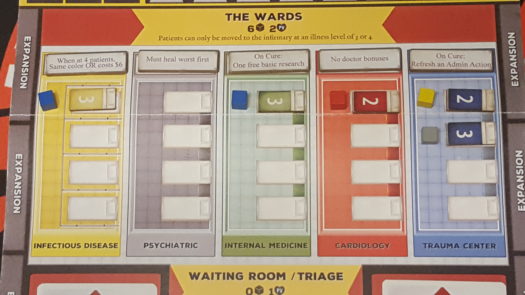
Players Phase
In the Player’s phase, players will be using the action tokens from the 4 doctors and 1 administrator. The actions players can take with these tokens include:
- Transferring a patient
- Healing a patient
- Building an improvement
- Hiring staff
- Conducting research
- Training a doctor
- Using the admin’s special action
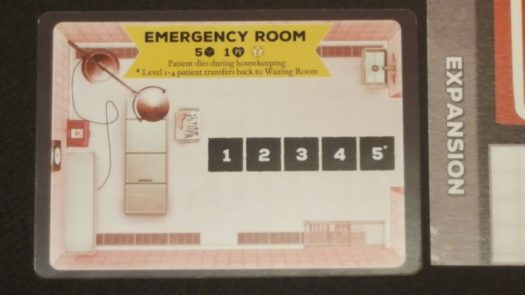
Most of the actions are self explanatory, so I’ll only go into detail about Healing a Patient.
Patients are healed by drawing the number of cubes as stated by the ward and drawing any bonuses afforded by doctor, staff and training bonuses. They then compare the color of the cubes with the patient bed they are drawing for.
For each matching cube, the patient is healed by 1. For each black cube the patient gets worse. Each time you cure a patient, you earn $1 times the patient value of the area you’re curing in.
For example, in the wards the patient value is 2, so each time you heal a patient by one you earn $2. If you completely heal the patient you also earn one Prestige times the patient value.

Death – Patients die when their sickness gets to 5 (or 6 when in an O.R. or E.R.) and players must move them to the cemetery. Each cemetery space costs the hospital money based on the patient value and available opening at the cemetery, getting more expensive with each death.

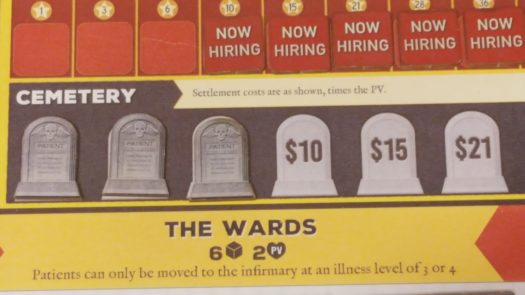
Housekeeping Phase
Once all players have played all their action tokens, they go into the Housekeeping phase. During this part of the game, players will apply any benefits from staff hires, update the job line, check the emergency room (if built) for patients that are still there (which if they are, they die), check the clinic (if built) releasing any patients there, check any operating rooms (if built), restock the cube cup with discarded cubes, and flip all action tokens back to their unused side.
Play continues by going back to the Ambulance phase. If after the complete Ambulance phase, there are no ambulance cards left the players win!
They then check their Prestige against the chart in the rulebook to see how they did.
If at any time the players run out of money or the cemetery is overrun with dead patients, the players lose.
There are still a number of details we didn’t cover, but this should give you a good idea of the game flow.
What we liked about Healthy Heart Hospital
First of all, if you know me and have followed my reviews, you know I like cooperative games. There is something about working together instead of against others that is appealing for me. Many gamers find co-ops lacking, as they don’t like the tendency for some players to take control and make it a solo game with onlookers. For me, I really enjoy getting everyone involved and having players make their own decisions, so that issue goes away.
Healthy Heart Hospital is a fantastic game as the decisions that need to be made are important and have significant consequences throughout the game. The decisions are widely varied as well with many choices of actions during the Player Phase, so players will need to use them wisely.
Choosing between actions like doing research that will be beneficial later in the game or getting a patient out of one of the wards can be a tough choice but a rewarding one.
The Ambulance phase of the game has to be the most disheartening part as you watch more sick people enter the hospital while those that are already there get worse. Sometimes there is nothing you can do but sit back and watch the carnage unfold.
Upgrading the hospital, doing research, and hiring staff are really good ways to get a head of the curve and also makes the game super enjoyable. Similar to an engine building game, it’s fun watching something you built come to life and work for your benefit. And with all the different upgrades, staff, and training available, your games can be very different from one another.
The biggest downside for this game is the luck of drawing cubes. It can be pretty disheartening when you pull black cubes at the most inopportune time. Thankfully this luck can be mitigated to some degree with the upgrades mentioned above.
You can also vary the difficulty level of each game by changing the number on the Ambulance Cards (decreasing it by one or more) or adding extra money during the set up. This is great for when you are first trying out the game or playing with less experienced players.
For my tastes, the components are decent and the artwork is sufficient. They won’t win any awards but the game play makes up for any lack in this department.


How does Healthy Heart Hospital score on our “Let’s Play Again” game meter?
 For me personally, I love Healthy Heart Hospital and see playing it again and again. Between the tough choices and the replayability it’s a win for me.
For me personally, I love Healthy Heart Hospital and see playing it again and again. Between the tough choices and the replayability it’s a win for me.
As mentioned above, there is a lot of replayability and the games feel very different based on your overall strategy. Add that with the option of changing up the level of difficulty and you’ve got a game you can play again and again.
That all being said, it’s a bit more complicated than a lot of other cooperative games we have on our shelves so my family tends to gravitate to those first. That is not to say it’s a bad game, but one that more experienced players might enjoy more.
If you’re looking for a tough but rewarding cooperative game, Healthy Heart Hospital is a good choice.
About the Author
Dane is an Advertising Manager for a national magazine by day and a husband, father of four, and board gamer by night (and mornings). He has a passion for board games and believes board games help bring families closer together while providing kids a unique way to learn many diverse skills. And he thinks they are downright fun!!!
We’d like to thank Victory Point Games for a review copy of Healthy Heart Hospital.




